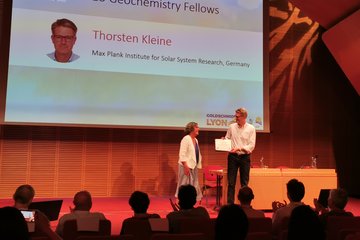Alle Typen
141.
Zeitschriftenartikel
Low-frequency electromagnetic waves and instabilities within the Martian bi-ion plasma. Earth, Planets and Space 50, S. 269 - 278 (1998)
142.
Zeitschriftenartikel
Nonlinear waves and discontinuities in the Martian magnetosheath. Observations and 2D bi-ion simulations. Earth, Planets and Space 50, S. 793 - 801 (1998)
143.
Zeitschriftenartikel
Wave observations at the foreshock boundary in the near Mars space. Earth, Planets and Space 50, S. 439 - 444 (1998)
144.
Zeitschriftenartikel
Ion and electron heating at the Martian bow shock. Common for bow shocks or not? Earth, Planets and Space 50, S. 289 - 294 (1998)
145.
Zeitschriftenartikel
Wavelet application to the magnetic field turbulence in the upstream region of the Martian bow shock. Earth, Planets and Space 50, S. 699 - 708 (1998)
146.
Zeitschriftenartikel
Solar wind magnetic holes: Signatures of slow-mode type MHD solutions. Advances in Space Research 20, S. 69 - 74 (1997)
147.
Zeitschriftenartikel
The Martian magnetosheath: Phobos-2 observations. Advances in Space Research 20, S. 149 - 153 (1997)
148.
Zeitschriftenartikel
The depletion of the solar wind near Mars. Advances in Space Research 20, S. 143 - 147 (1997)
149.
Zeitschriftenartikel
Bi-ion structuring in the magnetosheath of Mars: Theoretical modelling. Advances in Space Research 20, S. 137 - 142 (1997)
150.
Zeitschriftenartikel
Solar wind-Pluto interaction revised. Advances in Space Research 20, S. 295 - 299 (1997)
151.
Zeitschriftenartikel
'Phobos events': Signatures of solar wind - dust interaction. Planetary and Space Science 44, S. 589 - 601 (1996)
152.
Zeitschriftenartikel
Structuring of the transition region (plasma mantle) of the Martian magnetosphere. Geophysical Research Letters 23, S. 785 - 788 (1996)
153.
Zeitschriftenartikel
Plasma characteristics of the boundary layer in the martian magnetosphere. Journal Geophysical Research 101, S. 27061 - 27075 (1996)
154.
Zeitschriftenartikel
Bi-ion discontinuities at weak solar wind massloading. Physica Scripta T63, S. 111 - 118 (1996)
155.
Zeitschriftenartikel
Bow shock 'splitting' in bi-ion flows. Geophysical Research Letters 23, S. 3643 - 3646 (1996)
156.
Zeitschriftenartikel
Deimos - an obstacle to the solar wind. Science 269, S. 1075 - 1078 (1995)
157.
Buchkapitel
Induced Magnetospheres: Mars. In: Magnetospheres in the Solar System, S. 391 - 406 (Hg. Maggiolo, R.; André, N.). Wiley, Hoboken (2021)
158.
Buchkapitel
20 - Ultra-Low Frequency Waves at Venus and Mars. In: Low-Frequency Waves in Space Plasmas, Geophysical Monograph 216, S. 343 - 364 (Hg. Keiling, A.; Lee, D.-H.; Nakariakov, V.). American Geophysical Union. Published 2016 by John Wiley Sons, Inc., Hoboken, NJ, USA (2016)
159.
Buchkapitel
Ultra-Low-Frequency Waves at Venus and Mars. In: Low-Frequency Waves in Space Plasmas, S. 343 - 364 (Hg. Keiling, A.; Lee, D.-H.; Nakariakov, V.). Wiley (2016)
160.
Buchkapitel
Magnetotails of Mars and Venus. In: Magnetotails in the Solar System, Bd. 207, S. 43 - 59 (Hg. A. Keiling, C. M. J.; Delamere, P. A.). John Wiley Sons, Hoboken, NJ, USA (2015)











